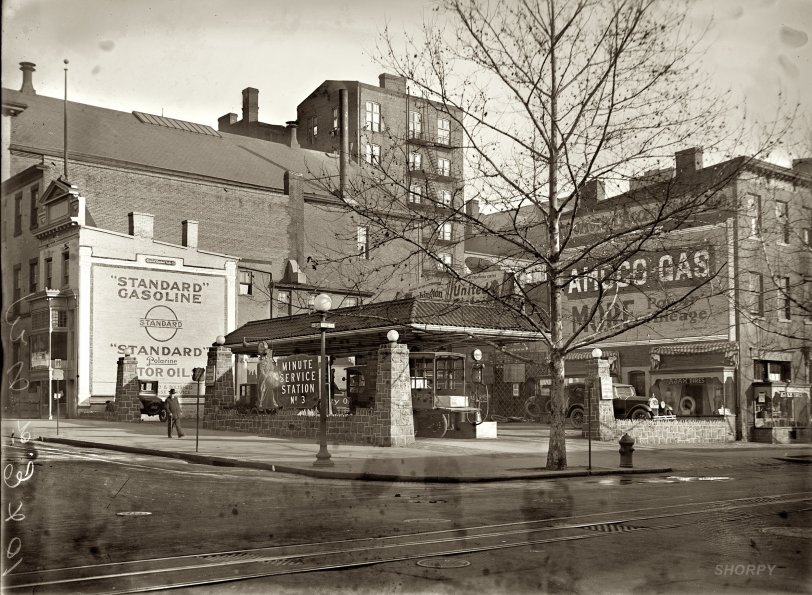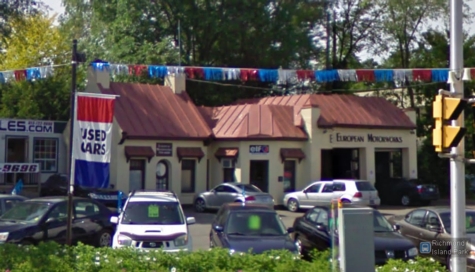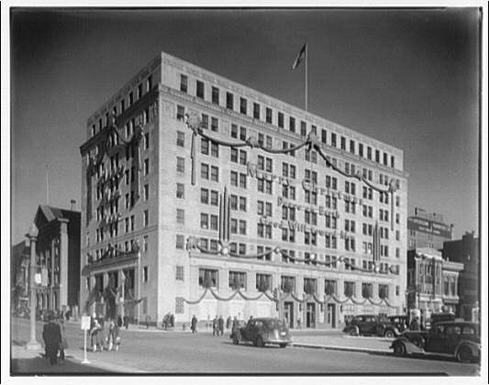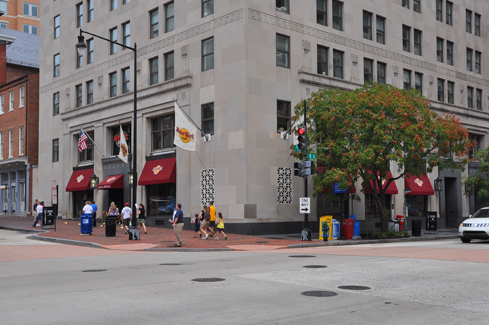


Framed or unframed, desk size to sofa size, printed by us in Arizona and Alabama since 2007. Explore now.
Shorpy is funded by you. Patreon contributors get an ad-free experience.
Learn more.

- Details, Details
- What's that building to the left of the tower?
- Coal Barges
- Bromo-Seltzer
- Inner harbor
- The Basin
- What a headache!
- Giant stepladder?
- Baldwin 62303
- Baldwin VO-1000
- Cold
- No expense spared
- Tough Guys
- Lost in Toyland
- And without gloves
- If I were a blindfolded time traveler
- Smoke Consumer Also Cooks
- Oh that stove!
- Possibly still there?
- What?!?
- $100 Reward
- Freeze Frame
- Texas Flyer wanted
- Just a Year Too Soon
- WWII -- Replacing men with women at the railroad crossing.
- Yes, Icing
- You kids drive me nuts!
- NOT An Easy Job
- I wonder
- Just add window boxes
Print Emporium
Minute Service Station: 1925

1925. "Minute Service Station No. 3, 10th and E Streets N.W." A Standard Oil gas station in Washington, D.C. National Photo Co. glass negative. View full size.
10th & E Sts NW
The building now housing the Hard Rock Cafe was Potomac Elecric Power Company's general office until it moved to Pennsylvania Avenue in the 1970s. The original DC substation supplying the local 250-volt Edison system as well as the 600-volt street railway was across 10th Street from Ford's Theater. The "Lincoln" substation is long gone, along with the street railway, but the building was still there in commercial use last time I was in the area.
Tile Style redux
That was a common style of architecture for filling stations all over North America (probably in the UK, too).
There are still a few examples extant, here in Ottawa. many, though, are gone. There was one at the main corner of the neighbourhood where we lived for over 30 years. It was torn down in the 1980s.
The best preserved is at Main Street and Hawthorne Ave., now an architect's office.
The second has been a used car dealership for decades and up until recently pretty run down. It has been renovated but the tile roof has been replaced with flat tin. At least it has been saved.


+85?
Below is the view of the northeast corner of 10th and E Streets, NW taken in September of 2010. I'm not entirely convinced the 1925 shot is that corner. The extended roof does look like a theater and it could indeed be Ford's Theatre (the detail barely in the frame on the base of the roofline look like the current view) and the three-storey building immediately next door that was converted later into a ticket booth does look similar (although the second storey windows appear to be taller in the 1925 shot). However, the photo of the Potomac Electric Power Company Building taken in 1938 (which now is the Hard Rock Cafe) below which then occupied that corner does not show the three-storey building. It does show the vent pipe on the roof of what appears to be the theater building where today there is a larger vent structure reproduced on the roof of Ford's to look like the original. I'm also unsure as to when the Potomac Building was constructed which could rule out that corner if it predated 1925 (perhaps Stanton_Square could work his magic on that). It was also noted that the back of a building on F Street can be seen, but I do not know what the backs of those buildings look like (they are still there, though). I have seen photographs of the northwest corner from about 1900 and 1940, and I know that that couldn't be the corner where the station was located. However, where the FBI building now stands on the southeast corner and across the street on the southwest corner are possibilities (there were several theaters in that area). Then again the incline of the street would seem to indicate that this is indeed the proper view.


Street Car Tracks
Is that a cable car track in the foreground?
[No, they're for electric streetcars with third-rail power. - Dave]
Robert Beresford, Modern architect
It is amazing to compare the modernity of this service station with others recently posted to Shorpy
https://www.shorpy.com/node/3535
https://www.shorpy.com/node/3510
https://www.shorpy.com/node/3515
The roof over the pumps is a feature greatly replicated in modern stations both for the function (protection from the elements) as well as style.
Robert Beresford, a local architect, designed many residences as well as contributing to the Mayflower hotel.
"Robert F. Beresford spoke on "Colonial Architecture." Beresford designed hundreds of Colonial style homes in the Washington area. In 1923 and 1924 he worked with the New York firm of Warren & Wetmore (architects of New York's Grand Central Terminal) on the design of the Hotel Walker [now the Mayflower Hotel]. In 1927 and 1928 he designed Washington's only Art Deco office building, the Tower Building at 1401 K Street, N.W."
http://users.starpower.net/oshel/H05.htm
http://en.wikipedia.org/wiki/Mayflower_Hotel
http://en.wikipedia.org/wiki/Warren_and_Wetmore
Tile Roofs
That sort of barrel tile roof isn't uncommon in buildings from the twenties and thirties. There seems to have been a Spanish influenced design craze in this period. I know of several buildings here in Saskatoon from this period that have exactly that type of roof.
Tile Style
I'm surprised to see that tile roof over the filling station. That style is everywhere here in Southern California, looking almost exactly the same.
Minute Service Station
Washington Post Oct 8, 1922
Extensive improvements have just been completed at the Automotive Accessories Company which conducts a large filling station and accessory business at Tenth and E streets northwest.
A large tile canopy has been placed over the pump platform and several oil and gasoline pumps have been added. Driveways have been widened and other improvements made to facilitate service. The downtown station is in [the] charge of Henry J. Sterzer. William T. and C.E. Calliher and Allan E. Walker are the proprietors.
Washington Post May 25, 1924
Modern Gas Tanks Give Real Service, Sterzer Declares
Founder of "Minute Stations" Says Public Appreciates Saving of Time.
Present Plants Represent an Investment of $1,000,000 in District Alone.
The fine, modern filling station, conveniently located and well managed, renders a real service to the motoring public. It is a highly specialized business, requiring intelligent study, progressive methods and large investment.
This is the opinion of Henry J. Sterzer, general manager of the Minute service stations, which have been pioneers in placing the sales of gasoline, oils, filling station service and accessories on a higher plane in the National Capitol.
Mr Sterzer says the prime requisite for a site for a modern filling station, is not only location on a prominent thoroughfare, but the use of sufficient ground space to permit the construction of very wide driveways and the placing of pumps sufficient distances apart. The combination of wide driveways and multiple pumps permits easy entrance and exit, makes blockades impossible and difficult maneuvering with danger to fine cars unnecessary.
"Robert F. Beresford, architect of the Minute service stations, has made wide driveways and numerous pump locations a feature of his plans at all the stations," said Mr. Sterzer.
...
"Experience has taught us that the average motorist appreciates the definite knowledge that he is receiving the exact amount of gasoline or oil that he pays for. For that reason all of our stations are equipped with Fry visible measure pumps, which not only give absolutely accurate measurements mechanically, but which measurement can be checked visually."
...
The minute service stations, which represent an investment considerably in excess of $1,000,000 include the following: American Accessories company at Georgia avenue and Upshur streets northwest; the Automotive Accessories Company at Tenth and E streets northwest; the Automotive Supply Company at Twenty-First and Pennsylvania avenue northwest; the L Street Garage at 1705 L street northwest; the Linworth Auto Supply company at Linworth and C sreets southwest and the Washington Accessories company at Seventeenth and L streets northwest.
10th and E Again
That's the current site of the Hard Rock Cafe.
That small building next to the station is now incorporated into Ford's Theater as the ticket booth, and at one time was the Star Saloon.
The larger building is Ford's Theater, and I believe the building with the fire escapes is the rear of the Atlantic building. You can barely make out the roof of the National Union Fire Insurance building at 918 F St. in the back.
10th and E
Ah, that corner is now right across from the FBI's Hoover Building, and of course, just up the block from there is Ford's Theatre, where the infamous play "Our American Cousin" once played. In fact, if this is a northeast-facing view, then wouldn't that be the rear of the theatre building at upper left?
























On Shorpy:
Today’s Top 5